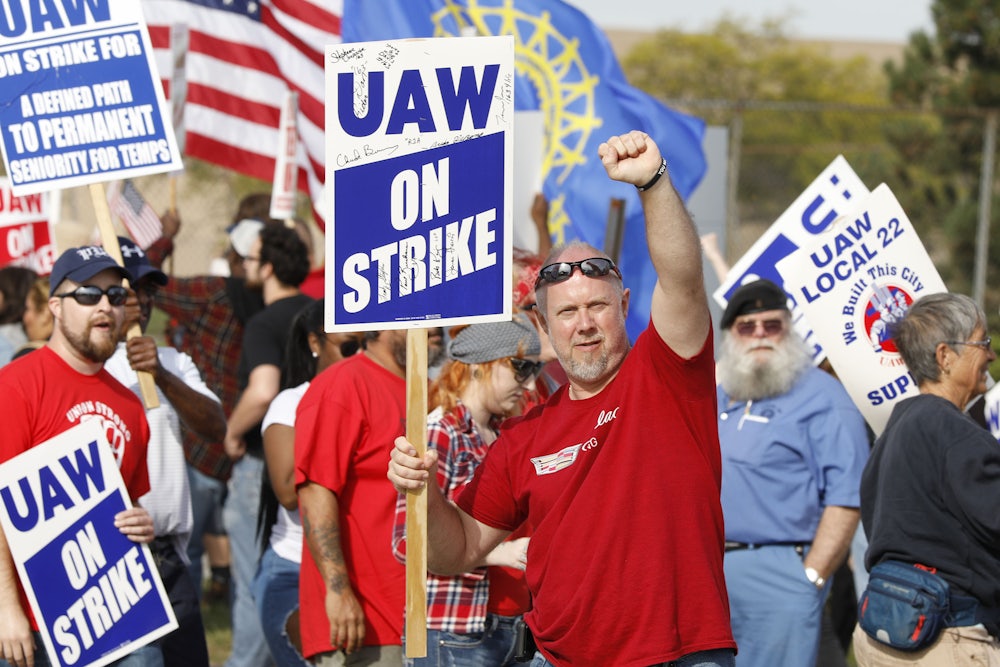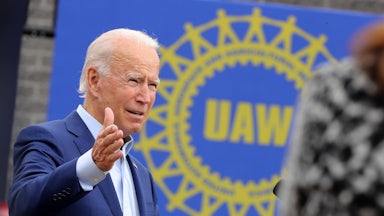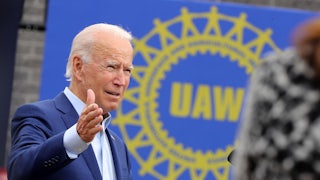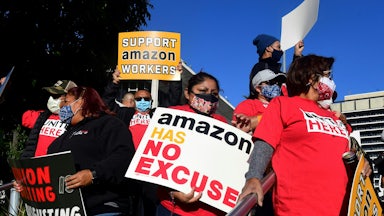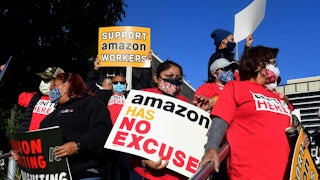The most monumental pro-labor legislation since the 1930s is a few co-sponsors shy of a majority in the Senate, and it’s tough to overstate what a big deal that is: The Protect the Right to Organize Act promises to largely revert the United States back to the friendlier New Deal era of labor law, before postwar Republican majorities moved to significantly tamp down organized labor with the 1947 Taft-Hartley Act. If passed, the law will make more workers eligible for collective bargaining, make unions easier to organize, limit the power of management to sabotage the process and punish those who do more harshly, deliver speedier contracts, and lend existing unions more muscle. The bill’s ultimate outlook is still a toss-up: While President Biden has affirmed his strong support of the bill, advocates will have to fight hard to clinch the Senate’s five Democratic holdouts, let alone to nuke the filibuster so that 50 votes is enough to carry the day.
Nevertheless, several AFL-CIO unions are pushing hard alongside like-minded groups to win what they deem their top legislative priority, which experts estimate could double union density in the U.S. But the law’s promise goes well beyond unions: By securing the legal framework for a resurgent, militant labor movement, the PRO Act could bring staggeringly ambitious demands like Medicare for All within our collective reach.
It’s no stretch to imagine that significantly upping union density—something experts claim the PRO Act is well situated to do—could shift the political landscape in this country. A wealth of evidence links union membership to greater political participation: One study of behavior from 1973 to 1994 found that members of a union were 18 percent more likely to vote, 43 percent more likely to volunteer for campaigns, and up to 93 percent more likely to attend protests. Organized workers are also likely to become more politically informed on the job than their unorganized counterparts. Unionized people across all nations are also more likely to engage in other forms of direct action. The impact of this civic engagement may well reverberate beyond unions themselves: So-called “right to work” laws designed to depress union rolls reportedly depress overall voter turnout in a state, costing Democrats a full 3.5 percent of their vote share. More densely unionized states tend to have more progressive taxation and more generous social programs.
A growing constituency of organized workers could also shift political priorities. There’s a reason leftists are so obsessed with unions—beyond being a mechanism for members to improve their lives, they’re a vehicle for class struggle writ large. “Part of the problem we have as progressives in the U.S. is that there’s been a systematic dismantling of institutions that progressive fights are waged by,” Jonah Furman, the former labor organizer for the Bernie Sanders campaign, told The New Republic. “Countries with social democracy, they always have high union density.… If there’s no organization to fight for our class interests, then you can’t really win fights around those class interests, and you get into a death spiral—which is basically what happened with class politics in the U.S.”
It’s no surprise that at a moment when the gap between rich and poor is wider than it’s been in a century, union membership is also at its lowest—hovering around 6 percent for private sector workers. The death spiral Furman described has been decades in the making, gradually eroding the power of labor relative to capital. Since organized labor’s high point during the New Deal era, which stretched from the 1930s to the 1970s, the capital class has waged a strategic counterattack, encompassing everything from the decimation of unions, the rise of free trade, the privatization of public goods, and the gutting of welfare spending. As workers’ piece of the overall pie shrank, so too did their political might, leaving them less equipped to fight in solidarity with one another and win things that might cost extremely rich people money.
That rightward lurch has forced many of the unions left standing into what is often described as a “defensive crouch,” relegating many of them to fight to maintain what they’ve already won instead of making bolder demands or fighting on behalf of their broader communities. Labor’s ambivalence about Medicare for All illustrates this dynamic: While many unions have officially endorsed Medicare for All or even campaigned for it, others have been hesitant to back a policy that would involve them giving up health care coverage for which their members have bargained.
There are signs of a sea change: While UniteHere’s Las Vegas local famously objected to Medicare for All in favor of their plans during the 2020 primary, the rank and file overwhelmingly caucused for Sanders—suggesting a mismatch between members and leadership. The logic of endorsing Medicare for All is that if everyone is on a government-funded plan, unions won’t need to bargain for health coverage, always one of the most contentious issues during negotiations. The more progressive voices in labor understand this: As Flight Attendants Union leader Sara Nelson put it in a fiery endorsement of Medicare for All, “What we legislate, we don’t have to negotiate.”
While it isn’t typically framed as such, the fight for Medicare for All is an epic battle against capital: Health care, after all, is a $3.5 trillion industry comprising nearly one-fifth of the U.S. economy, the profitability of which depends on providers’ near-unilateral ability to command high reimbursements and a highly exploited workforce of low-waged care workers at the bottom. Compelling the people with a financial stake in maintaining that system to give it up will take more than moral appeals. But too often, advocacy for Medicare for All gets flattened into wonky debates.
As Andy Hyatt, the Massachusetts Vice President of the Committee of Interns and Residents—a union of health care trainees organized under the Service Employees International Union—put it, “When it comes to the Medicare for All movement, our power analysis hasn’t always been great.… There’s been an assumption that if we can get the facts right, if we can just show people the right data, we can make the right argument, convince people on Capitol Hill that Medicare for All is good, and win,” he said. (Full disclosure: My husband and I socialize with Hyatt and have both worked with him on various Medicare for All organizing projects.) “But I think what we have to realize is our opponents are some of the most powerful, wealthy corporations in American history! We’re talking at least comparable [to] steel barons and railroad magnates.” Defeating them requires a far better-organized working class than currently exists.
However important issue-based advocacy groups may be, they simply can’t muster the power that unions can. That’s not because workers are noble or magic, but because they have something that capital needs to generate profits: labor power, which unions pool into units large enough to hold leverage over bosses in a way that brilliantly crafted and popular policy arguments simply aren’t capable of doing on their own.
While the PRO Act doesn’t automatically reverse the tides of class power, it does make doing so possible. Polls suggest that over half of workers report wanting to join a union if they could, a number Furman argues is so much higher than actual membership rates largely because of steep obstacles the PRO Act would go a long way to smooth out: “Right now, if someone says they want to join a union, almost everything tells you not to do it,” Furman said. “You’re likely to get fired, you probably won’t win the union, you’re likely not to win a first contract. And if you do all those things, best-case scenario is in five years you might get a raise.” The PRO Act would change those odds and encourage organizing campaigns.
But the end goal isn’t for employees to raise their wages through bargaining—that’s only the beginning. Newly unionized workers are, by definition, people who have already waged and won a political fight. Not only does that victory make a bolder vision of what’s politically possible seem more credible, it also sharpens the skills organizers need to win bigger things—like the ability to take health care off the bargaining table for good. “I don’t think you snap your fingers and we suddenly have universal social programs,” Furman explained. “But it’s very hard to imagine how you get to universal social programs without doubling the strength of the labor movement.”
